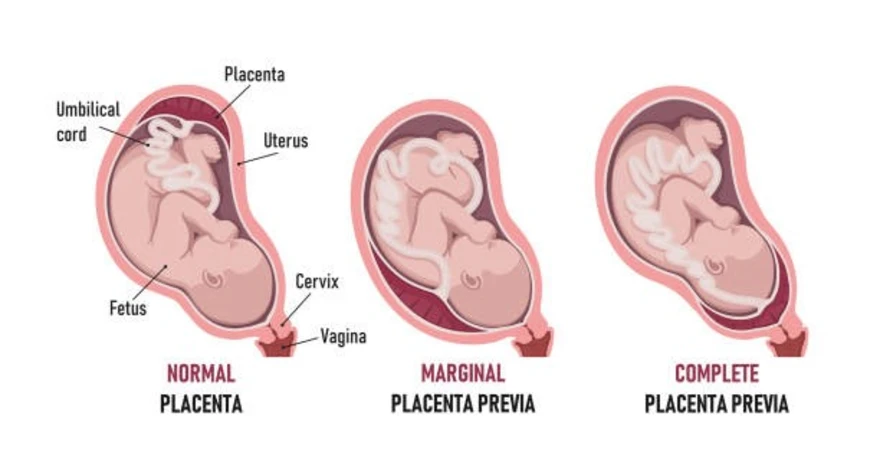Preventive Healthcare
Exploring Placenta Previa: Types, Symptoms, Causes, and Treatment

Table of Contents
- Introduction
- What is Placenta Previa?
- What are the Types of Placenta Previa?
- How Common is Placenta Previa?
- What are the Symptoms of Placenta Previa?
- What Causes Placenta Previa?
- What are the Risk Factors for Developing Placenta Previa?
- What are the Possible Complications of Placenta Previa?
- Can You Have Placenta Previa Without Bleeding?
- Can Placenta Previa Cause a Miscarriage?
- How is Placenta Previa Diagnosed?
- What Tests are Used to Diagnose Placenta Previa?
- How is Placenta Previa Treated?
- Does Placenta Previa Go Away?
- Can I Reduce My Risk for Placenta Previa?
- What Can I Expect if I Have Placenta Previa?
- Will My Baby Be Born Early if I Have Placenta Previa?
- Can I Still Have a Vaginal Delivery with Placenta Previa?
- Can Placenta Previa Cause Birth Defects?
- Will I Get Placenta Previa Again?
- Can I Exercise with Placenta Previa?
- Can I Have Sex if I Have Placenta Previa?
- When Should I See My Doctor?
- Conclusion
Introduction
Pregnancy is a beautiful yet transformative stage in a woman's life. Navigating it can be thrilling and daunting for you. Placenta Previa, a pregnancy concern, will be explored here— covering types, symptoms, causes, and more to address your questions and concerns.
What is Placenta Previa?
Placenta previa is when your baby's oxygen and nutrient supplier, the placenta, grows in the lower part of your womb and covers the opening (cervix), where the baby usually comes out during normal delivery.
What are the Types of Placenta Previa?
There are three types of placenta previa:
Complete Placenta Previa:
Complete placenta previa covers the cervix, often necessitating a cesarean section for safe delivery. Placenta previa type is a crucial factor in determining the delivery method.
Partial Placenta Previa:
Partial placenta previa partly covers the cervix, presenting a lower complication risk than complete placenta previa. Understanding placenta previa type guides healthcare decisions for a safer pregnancy.
Marginal Placenta Previa:
In marginal placenta previa, the placenta edge is near the cervix but does not cover it entirely. This placenta previa type is less critical and may adjust as your womb stretches during pregnancy. The distinction in placenta previa type influences the monitoring and care plan for expectant mothers.
How Common is Placenta Previa?
Placenta previa is uncommon, happening in about 1 in 200 pregnancies. It is crucial to be aware of this to prevent risks during pregnancy.
What is the Difference Between Placenta Previa and Placental Abruption?
Placenta previa is about the placenta's position. Abruption is when the placenta detaches early from the uterine wall. This abruption can be chronic or sudden due to car accidents or falls.
Is Placenta Previa the Same as Anterior Placenta?
No, placenta previa is when the placenta covers your cervix, while anterior placenta means the placenta is attached to the front of the uterus. If it stays in front, it might block the cervix and cause placenta previa, leading to bleeding and complications.
What are the Symptoms of Placenta Previa?
Placenta previa symptoms may include:
- Unexpected bright red bleeding at the end of the second or start of the third trimester, which can be severe and stop on its own but may return days or weeks later.
- You might or might not have cramps along with the bleeding as a placenta previa symptom.
- You may go through labour within a few days of heavy bleeding or even after it begins.
What Causes Placenta Previa?
The exact placenta previa causes are unknown. However, your medical history or lifestyle may impact your pregnancy.
What are the Risk Factors for Developing Placenta Previa?
These are a few risk factors that can cause placenta previa:
- Large placenta
- Abnormal shape of a uterus
- Pregnant with triplets.
- History of uterine fibroids
- Previous history of uterus surgery, including cesarean sections
- Smoking
- Older than 35 years of age
What are the Possible Complications of Placenta Previa?
These are a few placenta previa complications to be aware of:
- Severe bleeding during pregnancy, labour, or delivery.
- Heavy bleeding may require a sudden C-section, even before full term.
- Excessive blood loss can cause anaemia, pale skin, and shortness of breath.
- If the placenta grows too deeply, it may lead to heavy bleeding after delivery.
- The placenta separating from the uterus wall can deprive the baby of oxygen and nutrients.
- Premature birth due to placenta previa may affect your baby's lung development.
Can You Have Placenta Previa Without Bleeding?
Yes, placenta previa without bleeding is possible. If you have mild or severe cramps or pelvic pain, inform your doctor and have regular check-ups for early detection. Never ignore placenta previa symptoms.
Why Do You Bleed When You Have Placenta Previa?
You bleed with placenta previa mainly because:
- In the third trimester, as your cervix thins for delivery, it can cause bleeding since the placenta is above the cervix.
- During delivery, the placenta attached to the uterus tears, causing bleeding from disrupted blood vessels.
Can Placenta Previa Cause a Miscarriage?
While placenta previa itself does not cause miscarriage, it increases the risk of complications that may lead to preterm birth or low birth weight.
How is Placenta Previa Diagnosed?
Placenta previa is typically diagnosed during a routine ultrasound around 20 weeks of pregnancy or when symptoms like vaginal bleeding occur.
What Tests are Used to Diagnose Placenta Previa?
For diagnosing placenta previa, your healthcare providers use ultrasounds, such as transvaginal and abdominal ultrasounds, to assess the baby's position, placenta, and cervix.
- The transvaginal ultrasound involves inserting a wand-like device into the vagina,
- The abdominal ultrasound applies gel to the abdomen and moves a device around the stomach.
These images help your doctor determine the extent of placental coverage over the cervix, guiding appropriate placenta previa treatment.
How is Placenta Previa Treated?
Placenta previa treatment may involve bed rest, hospitalisation, or, in severe cases, early delivery through the cesarean section to ensure the safety of both you and your baby.
Does Placenta Previa Go Away?
Placenta previa may resolve on its own as your pregnancy progresses, especially if detected earlier. However, if found later, closer to your delivery, it is less likely to go away.
Can I Reduce My Risk for Placenta Previa?
Despite some uncontrollable risk factors, a healthy lifestyle, regular check-ups, and following your healthcare provider's advice promote a smoother pregnancy.
What Can I Expect if I Have Placenta Previa?
Open communication with your healthcare provider is critical. They will guide you through the necessary precautions and monitor the condition to ensure a safe delivery.
Will My Baby Be Born Early if I Have Placenta Previa?
Preterm birth risk is managed by your healthcare team based on bleeding, baby's age, and placenta position, ensuring the best outcome for you and your baby.
Can I Still Have a Vaginal Delivery with Placenta Previa?
With marginal placenta previa (placenta near, not covering the cervix), vaginal delivery may be considered, but it carries bleeding risks. Nevertheless, your doctor will discuss the safest delivery option based on your placenta previa type.
Will I Need a C-Section if I'm Diagnosed with Placenta Previa?
In many cases, a cesarean section is recommended to minimise the risk of bleeding and ensure a safe delivery for both you and your baby.
Can Placenta Previa Cause Birth Defects?
It is not likely that placenta previa causes congenital disabilities, but premature babies may have low weight and respiratory issues due to underdeveloped lungs.
Will I Get Placenta Previa Again?
While it may recur in subsequent pregnancies, proper medical care and monitoring can significantly reduce the associated risks.
Will Placenta Previa Affect My Fertility?
Having any placenta previa type in one pregnancy does not necessarily impact your future fertility. Nevertheless, consulting with the healthcare provider for personalised guidance is ideal.
Can I Exercise with Placenta Previa?
No, exercise with placenta previa is off-limit due to the high risk of bleeding and early delivery.
Can I Have Sex if I Have Placenta Previa?
No, engaging in sexual activity can lead to bleeding, especially if your placenta is low and covering the cervix.
When Should I See My Doctor?
If you experience any placenta previa symptoms such as bleeding, abdominal pain, or other unusual symptoms, you should prompt an immediate consultation with your healthcare provider for proper evaluation.
Conclusion
Placenta previa is treatable, with most women delivering healthy babies. Open communication, regular check-ups, and following your health provider's guidance ensure the best outcome for you and your baby. Consider Metropolis Healthcare/Labs for accurate pre and postnatal diagnostic tests.

























